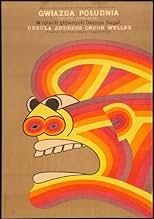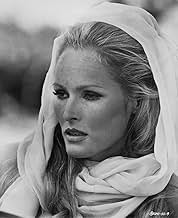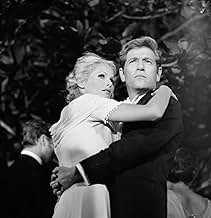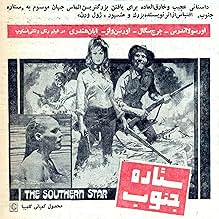IMDb RATING
5.4/10
661
YOUR RATING
In 1912 West Africa, diamond tycoon Kramer hires penniless American fortune hunter Dan Rockland, who's posing as a geologist, but when a huge diamond is found, everyone wants to steal it.In 1912 West Africa, diamond tycoon Kramer hires penniless American fortune hunter Dan Rockland, who's posing as a geologist, but when a huge diamond is found, everyone wants to steal it.In 1912 West Africa, diamond tycoon Kramer hires penniless American fortune hunter Dan Rockland, who's posing as a geologist, but when a huge diamond is found, everyone wants to steal it.
- Directors
- Writers
- Stars
- Directors
- Writers
- All cast & crew
- Production, box office & more at IMDbPro
Featured reviews
The Southern Star in question is the world's biggest diamond found in 1912 in French West Africa in a mine owned by Kramer (Andrews), whose daughter Erica (Andress) is engaged to Dan (Segal). The diamond is stolen and the chief suspect Matakit (played engagingly by Johnny Sekka), Dan's klepotomanic African friend, takes off. Dan and Erika take off after Matakit and the diamond. Karl, Kramer's security chief (Hendry), takes off after Dan, Erika Matakit and the diamond, hoping to win Erica in the process. To get to his home Matakit must cross territory controlled by Plankett (Welles), Karl's renegade predecessor.
We get to see lots and lots of sixties stock footage of African animals, we get to Andress topless, we get to see Welles ham it up. What we don't get is a good film. If you've nothing better to do for two hours on a wet afternoon you could do worse but you really should have something better to do.
The Southern Star is based on a novel by Jules Verne ,one published under a number of different titles .It is most widely known by the title used in the movie but has also been published as "The Southern Star Mystery" and "The Vanished Diamond".
The setting is French West Africa(changed from South Africa in the novel) and the period is immediately before the outbreak of World War One. The star is a large diamond which goes missing and is found by banjo playing American geologist Dan (George Segal).It is actually the property of business tycoon Kramer (Harry Andrews) whose daughter Erica (Ursula Andress)Dan is in love with .Complicating matters is the fact that Kramer's head of security Karl(Ian Hendry)is also after both the diamond and Erica and has a large force of men to ensure he gets both .In particular he has a sidekick Plankett (Orson Welles) a ,man fond of drilling his troops to records of bugle music .
The greatest asset of the movie is its striking location photography of Senegal which ensures the movie is always good to look at .It is also pretty well acted -although I did wonder how Ursula Andress managed to get her hands on full make up ,including mascara ,in the jungle .Welles in particular seems to be enjoying himself hugely .
the action when it comes is fine and the movie has a lot of humour -which is my big problem with it .I prefer my period adventure straight and details like the banjo playing and bugle records grate on me a tad Its a minor grouse ,nothing more and the movie is an enjoyable romp that may have relatively little to do with Verne but is a pleasant diversion on a wet and windy afternoon
The setting is French West Africa(changed from South Africa in the novel) and the period is immediately before the outbreak of World War One. The star is a large diamond which goes missing and is found by banjo playing American geologist Dan (George Segal).It is actually the property of business tycoon Kramer (Harry Andrews) whose daughter Erica (Ursula Andress)Dan is in love with .Complicating matters is the fact that Kramer's head of security Karl(Ian Hendry)is also after both the diamond and Erica and has a large force of men to ensure he gets both .In particular he has a sidekick Plankett (Orson Welles) a ,man fond of drilling his troops to records of bugle music .
The greatest asset of the movie is its striking location photography of Senegal which ensures the movie is always good to look at .It is also pretty well acted -although I did wonder how Ursula Andress managed to get her hands on full make up ,including mascara ,in the jungle .Welles in particular seems to be enjoying himself hugely .
the action when it comes is fine and the movie has a lot of humour -which is my big problem with it .I prefer my period adventure straight and details like the banjo playing and bugle records grate on me a tad Its a minor grouse ,nothing more and the movie is an enjoyable romp that may have relatively little to do with Verne but is a pleasant diversion on a wet and windy afternoon
An American comedy adventure; An impoverished Yankee geologist searches for a priceless diamond in Senegal. When his partner and the diamond vanish, the geologist is blamed for the crime, and a hunt ensues. Paint-by-numbers direction, poor dialogue, gratuitous photography of African wildlife in cutaway shots, but the cast make the best of it. George Segal shines. Orson Welles plays it wearily and fey with an upper-class English-London accent. Ian Hendry is impressive as the nasty hunter and Ursula Andress is gorgeous in resourceful support. All in all, the photography is good but the plot is preposterously simplistic.
Part of the Orson Welles Collection from Mill Creek DVD, this one opens with Dan (George Segal , the boss on "Just Shoot Me") sleeping on a cot, at a diamond mine; the book he was reading says "Geology for Beginners", so clearly he can't be trusted. The workers have found a giant diamond, and Dan arbitrarily decides that it is a genuine, valuable diamond. The beautiful Ursula Andress, famous for the James Bond films, and of course posing in Playboy, is in here. She is Erica, the daughter of the local rich man "Kramer", who has purchased or taken the diamond. Everybody is after the diamond, and wacky hyjinx follow. A hokey bar-room brawl. Ian Hendry seems to be the local deputy, but also seems to be involved in the shenanigans, as well as being Erica's ex. All rather confusing. Lots of old, faded, stock animal footage from old Africa, although it looks like some of the critters might be from Australia. or not. They end all up at the compound of "Plankett", a smaller role for Orson Welles. Good performance from Johnny Sekka.
Much female frontal nudity at the native dance scene. Jules Verne gets writing credit, but apparently it is a rewrite of an earlier novel. Directed by Sidney Hayers, who had worked on some films and whole lot of TV. A good watch... not anything spectacular, but it does have a comical flair to it. With the upbeat music, it's more of a madcap caper than a serious manhunt to the death.
Much female frontal nudity at the native dance scene. Jules Verne gets writing credit, but apparently it is a rewrite of an earlier novel. Directed by Sidney Hayers, who had worked on some films and whole lot of TV. A good watch... not anything spectacular, but it does have a comical flair to it. With the upbeat music, it's more of a madcap caper than a serious manhunt to the death.
Say Jules Verne and one has memories of cannons shooting men to the moon, or a mad sea captain destroying British ships with his personal submarine, or a proper Englishman betting 20,000 lbs (half his fortune) that he can get around the world in 80 days. And the movies have been kind to Verne's best known films: George Melies immortalized FROM THE EARTH TO THE MOON in an early film. Walt Disney did films on TWENTY THOUSAND LEAGUES UNDER THE SEA and THE CHILDREN OF CAPTAIN GRANT (the latter entitled IN SEARCH OF THE CASTAWAYS). Ray Harryhausen's special effects are one of the treats of MYSTERIOUS ISLAND. Mike Todd produced AROUND THE WORLD IN EIGHTY DAYS. And James Mason did make that JOURNEY TO THE CENTRE OF THE EARTH. What is usually not realized is the lesser known titles that have gotten onto the screen - for Jules Verne wrote nearly 80 novels. MICHAEL STROGOFF was made into a film in Great Britain in the 1930s with Anton Walbrook. FIVE WEEKS IN A BALLOON was made into a comedy adventure (with Sir Cedric Hardwicke and Red Buttons) in the 1960s. A Mexican version of the long forgotten EIGHT HUNDRED LEAGUES OVER THE AMAZON was made in the 1950s. A French version of MATTHIAS SANDORF (Verne's attempt at an updated version of THE COUNT OF MONTE CRISTO) was made starring Louis Jordan in the 1960s. And there was this little film, made in 1969.
What is frequently forgotten about Verne was that he was as preoccupied with politics as scientific developements. He usually was a liberal (one remarkable exception was his anti-Semitism, most markedly shown in his novel OFF ON A COMET - he also was convinced for years that Alfred Dreyfus was a traitor). In a late novel, THE DANUBE PILOT, he looks at the various warring nationalities in the Balkans and Austria Hungary. Another novel, THE SURVIVORS OF THE JONATHAN, dissects the various political philosophies of the day (Verne's hero is an anarchist). In the original THE SOUTHERN STAR Verne was taking a jaundiced eye at his particular bete noir - the British Empire in South Africa. The Boer - British rivalry there are a sounding board for looking at the society of South Africa. But one element is missing from the film. The villain is described as looking like Cecil Rhodes. But the villains in the film don't look like Rhodes.
Yet the film does get the relations of the three groups (native Africans, Boers, British) into some proportion. Ian Hendry is the real villain, having slowly made his way into a position of power over the career of his predecessor (and former patron) Welles, and hoping to take over Harry Andrews economic empire. Hendry romances Andrews niece, Andress, who is in love with Segal. As for Segal, he is friendly with Johnny Secca, who grew up with him. Andrews disapproves of this friendship, and Hendry detests the native Africans anyway. Andrews' diamond works has just produced the world's largest diamond - the "Southern Star". It is stolen and suspicion (fed by Hendry, and swallowed by Andrews) is that Secca stole it. Segal tries to help his friend (who is fleeing). Then Welles returns - he hopes to force Secca to give him the diamond, so he can regain his old position with Andrews.
The film is actually interesting enough to watch to its conclusion (and actually satisfactory even for Welles, as ambiguous a villain here as in some of his own films). It is not a great film by any stretch, but I would recommend seeing it.
What is frequently forgotten about Verne was that he was as preoccupied with politics as scientific developements. He usually was a liberal (one remarkable exception was his anti-Semitism, most markedly shown in his novel OFF ON A COMET - he also was convinced for years that Alfred Dreyfus was a traitor). In a late novel, THE DANUBE PILOT, he looks at the various warring nationalities in the Balkans and Austria Hungary. Another novel, THE SURVIVORS OF THE JONATHAN, dissects the various political philosophies of the day (Verne's hero is an anarchist). In the original THE SOUTHERN STAR Verne was taking a jaundiced eye at his particular bete noir - the British Empire in South Africa. The Boer - British rivalry there are a sounding board for looking at the society of South Africa. But one element is missing from the film. The villain is described as looking like Cecil Rhodes. But the villains in the film don't look like Rhodes.
Yet the film does get the relations of the three groups (native Africans, Boers, British) into some proportion. Ian Hendry is the real villain, having slowly made his way into a position of power over the career of his predecessor (and former patron) Welles, and hoping to take over Harry Andrews economic empire. Hendry romances Andrews niece, Andress, who is in love with Segal. As for Segal, he is friendly with Johnny Secca, who grew up with him. Andrews disapproves of this friendship, and Hendry detests the native Africans anyway. Andrews' diamond works has just produced the world's largest diamond - the "Southern Star". It is stolen and suspicion (fed by Hendry, and swallowed by Andrews) is that Secca stole it. Segal tries to help his friend (who is fleeing). Then Welles returns - he hopes to force Secca to give him the diamond, so he can regain his old position with Andrews.
The film is actually interesting enough to watch to its conclusion (and actually satisfactory even for Welles, as ambiguous a villain here as in some of his own films). It is not a great film by any stretch, but I would recommend seeing it.
Did you know
- TriviaThe rope bridge over the river is still intact in the Niokolo Koba National Park in Senegal and supports up to four people.
- Crazy creditsOpening credits prologue: FRENCH WEST AFRICA 1912
- SoundtracksThe Southern Star
Title Song Sung by Matt Monro
Music by Georges Garvarentz (uncredited)
Lyrics by Don Black
Performed by Georges Garvarentz Et Son Orchestre (uncredited)
Arranged by George Martin (uncredited)
Orchestrated by George Martin
- How long is The Southern Star?Powered by Alexa
Details
- Release date
- Countries of origin
- Language
- Also known as
- The Southern Star
- Filming locations
- Niokolo-Koba National Park, Senegal(filmed in Senegal)
- Production companies
- See more company credits at IMDbPro
- Runtime
- 1h 44m(104 min)
- Sound mix
- Aspect ratio
- 2.35 : 1
Contribute to this page
Suggest an edit or add missing content




























